Ke Qin
Bid Farewell to Seesaw: Towards Accurate Long-tail Session-based Recommendation via Dual Constraints of Hybrid Intents
Nov 11, 2025Abstract:Session-based recommendation (SBR) aims to predict anonymous users' next interaction based on their interaction sessions. In the practical recommendation scenario, low-exposure items constitute the majority of interactions, creating a long-tail distribution that severely compromises recommendation diversity. Existing approaches attempt to address this issue by promoting tail items but incur accuracy degradation, exhibiting a "see-saw" effect between long-tail and accuracy performance. We attribute such conflict to session-irrelevant noise within the tail items, which existing long-tail approaches fail to identify and constrain effectively. To resolve this fundamental conflict, we propose \textbf{HID} (\textbf{H}ybrid \textbf{I}ntent-based \textbf{D}ual Constraint Framework), a plug-and-play framework that transforms the conventional "see-saw" into "win-win" through introducing the hybrid intent-based dual constraints for both long-tail and accuracy. Two key innovations are incorporated in this framework: (i) \textit{Hybrid Intent Learning}, where we reformulate the intent extraction strategies by employing attribute-aware spectral clustering to reconstruct the item-to-intent mapping. Furthermore, discrimination of session-irrelevant noise is achieved through the assignment of the target and noise intents to each session. (ii) \textit{Intent Constraint Loss}, which incorporates two novel constraint paradigms regarding the \textit{diversity} and \textit{accuracy} to regulate the representation learning process of both items and sessions. These two objectives are unified into a single training loss through rigorous theoretical derivation. Extensive experiments across multiple SBR models and datasets demonstrate that HID can enhance both long-tail performance and recommendation accuracy, establishing new state-of-the-art performance in long-tail recommender systems.
Beyond Random: Automatic Inner-loop Optimization in Dataset Distillation
Oct 06, 2025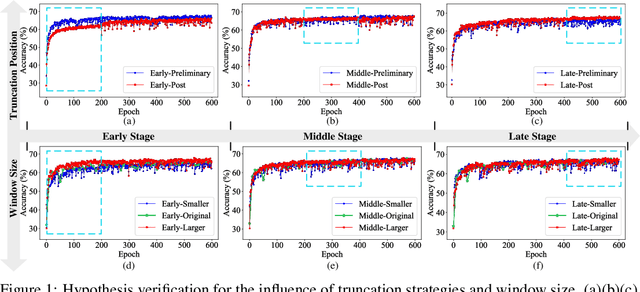
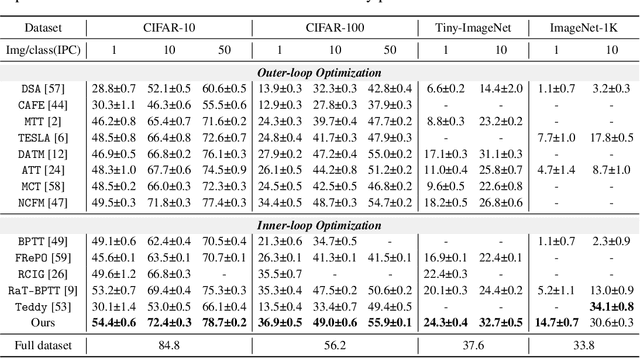
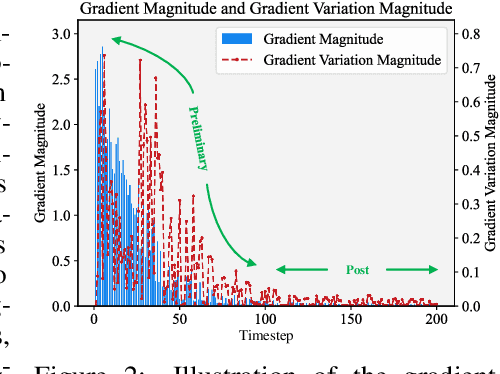
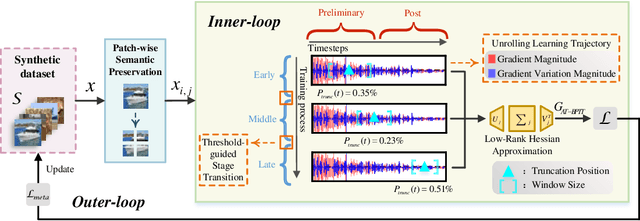
Abstract:The growing demand for efficient deep learning has positioned dataset distillation as a pivotal technique for compressing training dataset while preserving model performance. However, existing inner-loop optimization methods for dataset distillation typically rely on random truncation strategies, which lack flexibility and often yield suboptimal results. In this work, we observe that neural networks exhibit distinct learning dynamics across different training stages-early, middle, and late-making random truncation ineffective. To address this limitation, we propose Automatic Truncated Backpropagation Through Time (AT-BPTT), a novel framework that dynamically adapts both truncation positions and window sizes according to intrinsic gradient behavior. AT-BPTT introduces three key components: (1) a probabilistic mechanism for stage-aware timestep selection, (2) an adaptive window sizing strategy based on gradient variation, and (3) a low-rank Hessian approximation to reduce computational overhead. Extensive experiments on CIFAR-10, CIFAR-100, Tiny-ImageNet, and ImageNet-1K show that AT-BPTT achieves state-of-the-art performance, improving accuracy by an average of 6.16% over baseline methods. Moreover, our approach accelerates inner-loop optimization by 3.9x while saving 63% memory cost.
GraphCogent: Overcoming LLMs' Working Memory Constraints via Multi-Agent Collaboration in Complex Graph Understanding
Aug 17, 2025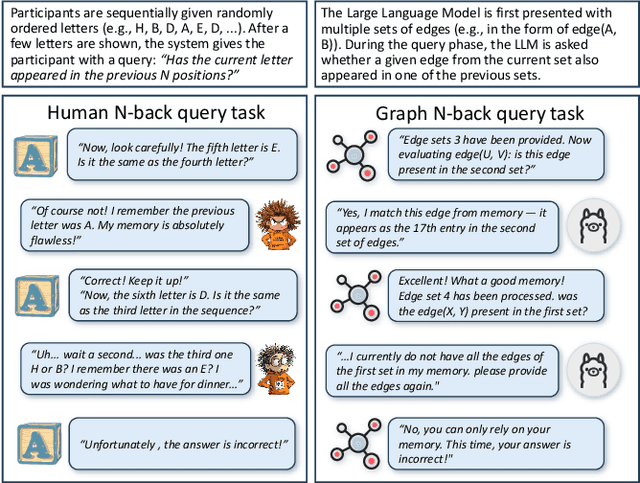
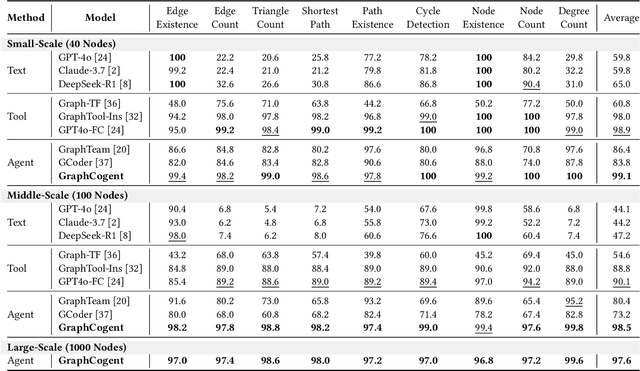
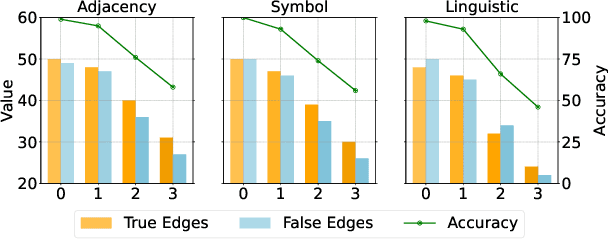

Abstract:Large language models (LLMs) show promising performance on small-scale graph reasoning tasks but fail when handling real-world graphs with complex queries. This phenomenon stems from LLMs' inability to effectively process complex graph topology and perform multi-step reasoning simultaneously. To address these limitations, we propose GraphCogent, a collaborative agent framework inspired by human Working Memory Model that decomposes graph reasoning into specialized cognitive processes: sense, buffer, and execute. The framework consists of three modules: Sensory Module standardizes diverse graph text representations via subgraph sampling, Buffer Module integrates and indexes graph data across multiple formats, and Execution Module combines tool calling and model generation for efficient reasoning. We also introduce Graph4real, a comprehensive benchmark contains with four domains of real-world graphs (Web, Social, Transportation, and Citation) to evaluate LLMs' graph reasoning capabilities. Our Graph4real covers 21 different graph reasoning tasks, categorized into three types (Structural Querying, Algorithmic Reasoning, and Predictive Modeling tasks), with graph scales that are 10 times larger than existing benchmarks. Experiments show that Llama3.1-8B based GraphCogent achieves a 50% improvement over massive-scale LLMs like DeepSeek-R1 (671B). Compared to state-of-the-art agent-based baseline, our framework outperforms by 20% in accuracy while reducing token usage by 80% for in-toolset tasks and 30% for out-toolset tasks. Code will be available after review.
Adaptive Dataset Quantization
Dec 22, 2024Abstract:Contemporary deep learning, characterized by the training of cumbersome neural networks on massive datasets, confronts substantial computational hurdles. To alleviate heavy data storage burdens on limited hardware resources, numerous dataset compression methods such as dataset distillation (DD) and coreset selection have emerged to obtain a compact but informative dataset through synthesis or selection for efficient training. However, DD involves an expensive optimization procedure and exhibits limited generalization across unseen architectures, while coreset selection is limited by its low data keep ratio and reliance on heuristics, hindering its practicality and feasibility. To address these limitations, we introduce a newly versatile framework for dataset compression, namely Adaptive Dataset Quantization (ADQ). Specifically, we first identify the sub-optimal performance of naive Dataset Quantization (DQ), which relies on uniform sampling and overlooks the varying importance of each generated bin. Subsequently, we propose a novel adaptive sampling strategy through the evaluation of generated bins' representativeness score, diversity score and importance score, where the former two scores are quantified by the texture level and contrastive learning-based techniques, respectively. Extensive experiments demonstrate that our method not only exhibits superior generalization capability across different architectures, but also attains state-of-the-art results, surpassing DQ by average 3\% on various datasets.
GraphTool-Instruction: Revolutionizing Graph Reasoning in LLMs through Decomposed Subtask Instruction
Dec 11, 2024



Abstract:Large language models (LLMs) have been demonstrated to possess the capabilities to understand fundamental graph properties and address various graph reasoning tasks. Existing methods fine-tune LLMs to understand and execute graph reasoning tasks by specially designed task instructions. However, these Text-Instruction methods generally exhibit poor performance. Inspired by tool learning, researchers propose Tool-Instruction methods to solve various graph problems by special tool calling (e.g., function, API and model), achieving significant improvements in graph reasoning tasks. Nevertheless, current Tool-Instruction approaches focus on the tool information and ignore the graph structure information, which leads to significantly inferior performance on small-scale LLMs (less than 13B). To tackle this issue, we propose GraphTool-Instruction, an innovative Instruction-tuning approach that decomposes the graph reasoning task into three distinct subtasks (i.e., graph extraction, tool name identification and tool parameter extraction), and design specialized instructions for each subtask. Our GraphTool-Instruction can be used as a plug-and-play prompt for different LLMs without fine-tuning. Moreover, building on GraphTool-Instruction, we develop GTools, a dataset that includes twenty graph reasoning tasks, and create a graph reasoning LLM called GraphForge based on Llama3-8B. We conduct extensive experiments on twenty graph reasoning tasks with different graph types (e.g., graph size or graph direction), and we find that GraphTool-Instruction achieves SOTA compared to Text-Instruction and Tool-Instruction methods. Fine-tuned on GTools, GraphForge gets further improvement of over 30% compared to the Tool-Instruction enhanced GPT-3.5-turbo, and it performs comparably to the high-cost GPT-4o. Our codes and data are available at https://anonymous.4open.science/r/GraphTool-Instruction.
Towards Effective Data-Free Knowledge Distillation via Diverse Diffusion Augmentation
Oct 23, 2024Abstract:Data-free knowledge distillation (DFKD) has emerged as a pivotal technique in the domain of model compression, substantially reducing the dependency on the original training data. Nonetheless, conventional DFKD methods that employ synthesized training data are prone to the limitations of inadequate diversity and discrepancies in distribution between the synthesized and original datasets. To address these challenges, this paper introduces an innovative approach to DFKD through diverse diffusion augmentation (DDA). Specifically, we revise the paradigm of common data synthesis in DFKD to a composite process through leveraging diffusion models subsequent to data synthesis for self-supervised augmentation, which generates a spectrum of data samples with similar distributions while retaining controlled variations. Furthermore, to mitigate excessive deviation in the embedding space, we introduce an image filtering technique grounded in cosine similarity to maintain fidelity during the knowledge distillation process. Comprehensive experiments conducted on CIFAR-10, CIFAR-100, and Tiny-ImageNet datasets showcase the superior performance of our method across various teacher-student network configurations, outperforming the contemporary state-of-the-art DFKD methods. Code will be available at:https://github.com/SLGSP/DDA.
MuAP: Multi-step Adaptive Prompt Learning for Vision-Language Model with Missing Modality
Sep 07, 2024



Abstract:Recently, prompt learning has garnered considerable attention for its success in various Vision-Language (VL) tasks. However, existing prompt-based models are primarily focused on studying prompt generation and prompt strategies with complete modality settings, which does not accurately reflect real-world scenarios where partial modality information may be missing. In this paper, we present the first comprehensive investigation into prompt learning behavior when modalities are incomplete, revealing the high sensitivity of prompt-based models to missing modalities. To this end, we propose a novel Multi-step Adaptive Prompt Learning (MuAP) framework, aiming to generate multimodal prompts and perform multi-step prompt tuning, which adaptively learns knowledge by iteratively aligning modalities. Specifically, we generate multimodal prompts for each modality and devise prompt strategies to integrate them into the Transformer model. Subsequently, we sequentially perform prompt tuning from single-stage and alignment-stage, allowing each modality-prompt to be autonomously and adaptively learned, thereby mitigating the imbalance issue caused by only textual prompts that are learnable in previous works. Extensive experiments demonstrate the effectiveness of our MuAP and this model achieves significant improvements compared to the state-of-the-art on all benchmark datasets
No Language is an Island: Unifying Chinese and English in Financial Large Language Models, Instruction Data, and Benchmarks
Mar 10, 2024



Abstract:While the progression of Large Language Models (LLMs) has notably propelled financial analysis, their application has largely been confined to singular language realms, leaving untapped the potential of bilingual Chinese-English capacity. To bridge this chasm, we introduce ICE-PIXIU, seamlessly amalgamating the ICE-INTENT model and ICE-FLARE benchmark for bilingual financial analysis. ICE-PIXIU uniquely integrates a spectrum of Chinese tasks, alongside translated and original English datasets, enriching the breadth and depth of bilingual financial modeling. It provides unrestricted access to diverse model variants, a substantial compilation of diverse cross-lingual and multi-modal instruction data, and an evaluation benchmark with expert annotations, comprising 10 NLP tasks, 20 bilingual specific tasks, totaling 1,185k datasets. Our thorough evaluation emphasizes the advantages of incorporating these bilingual datasets, especially in translation tasks and utilizing original English data, enhancing both linguistic flexibility and analytical acuity in financial contexts. Notably, ICE-INTENT distinguishes itself by showcasing significant enhancements over conventional LLMs and existing financial LLMs in bilingual milieus, underscoring the profound impact of robust bilingual data on the accuracy and efficacy of financial NLP.
Towards Lifelong Scene Graph Generation with Knowledge-ware In-context Prompt Learning
Jan 26, 2024Abstract:Scene graph generation (SGG) endeavors to predict visual relationships between pairs of objects within an image. Prevailing SGG methods traditionally assume a one-off learning process for SGG. This conventional paradigm may necessitate repetitive training on all previously observed samples whenever new relationships emerge, mitigating the risk of forgetting previously acquired knowledge. This work seeks to address this pitfall inherent in a suite of prior relationship predictions. Motivated by the achievements of in-context learning in pretrained language models, our approach imbues the model with the capability to predict relationships and continuously acquire novel knowledge without succumbing to catastrophic forgetting. To achieve this goal, we introduce a novel and pragmatic framework for scene graph generation, namely Lifelong Scene Graph Generation (LSGG), where tasks, such as predicates, unfold in a streaming fashion. In this framework, the model is constrained to exclusive training on the present task, devoid of access to previously encountered training data, except for a limited number of exemplars, but the model is tasked with inferring all predicates it has encountered thus far. Rigorous experiments demonstrate the superiority of our proposed method over state-of-the-art SGG models in the context of LSGG across a diverse array of metrics. Besides, extensive experiments on the two mainstream benchmark datasets, VG and Open-Image(v6), show the superiority of our proposed model to a number of competitive SGG models in terms of continuous learning and conventional settings. Moreover, comprehensive ablation experiments demonstrate the effectiveness of each component in our model.
Graph Entropy Minimization for Semi-supervised Node Classification
May 31, 2023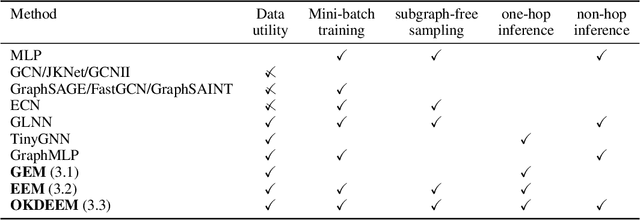
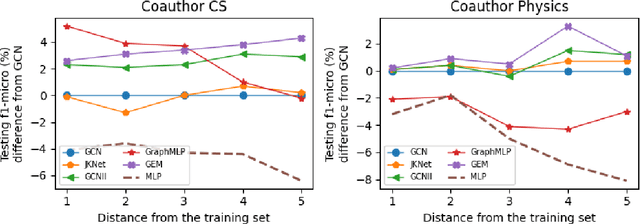
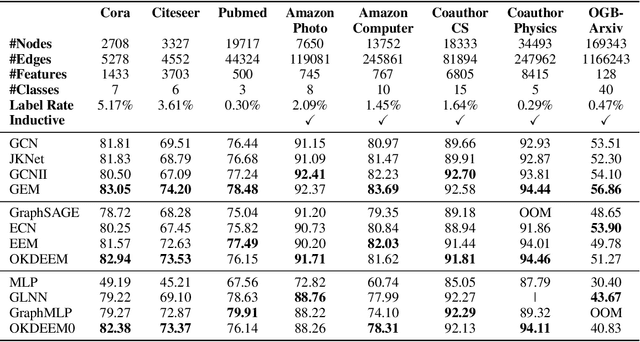
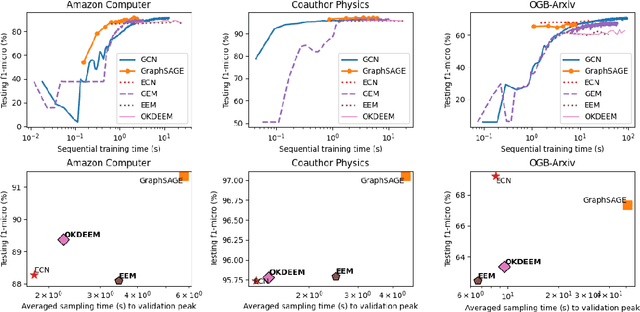
Abstract:Node classifiers are required to comprehensively reduce prediction errors, training resources, and inference latency in the industry. However, most graph neural networks (GNN) concentrate only on one or two of them. The compromised aspects thus are the shortest boards on the bucket, hindering their practical deployments for industrial-level tasks. This work proposes a novel semi-supervised learning method termed Graph Entropy Minimization (GEM) to resolve the three issues simultaneously. GEM benefits its one-hop aggregation from massive uncategorized nodes, making its prediction accuracy comparable to GNNs with two or more hops message passing. It can be decomposed to support stochastic training with mini-batches of independent edge samples, achieving extremely fast sampling and space-saving training. While its one-hop aggregation is faster in inference than deep GNNs, GEM can be further accelerated to an extreme by deriving a non-hop classifier via online knowledge distillation. Thus, GEM can be a handy choice for latency-restricted and error-sensitive services running on resource-constraint hardware. Code is available at https://github.com/cf020031308/GEM.
 Add to Chrome
Add to Chrome Add to Firefox
Add to Firefox Add to Edge
Add to Edge